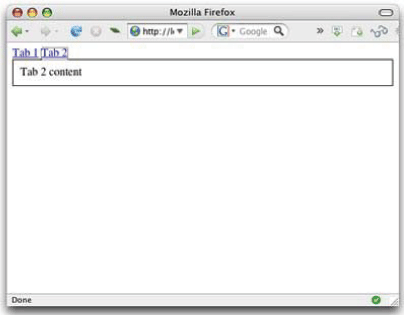|
Five common Ajax patterns |
| |
|
it in the tab area, as shown in Figure 3.
Figure 3. The content for the second tab

This is the quintessential use of this design pattern — to take requests from the user and update a
portion of the display with the new material, in this case, creating the illusion of a tabbed display.
The value from the application side is that you can downloaded a much lighter-weight page to
customers, who can then access the material they want on demand.
Before Ajax, the common technique was to have both tabs on the page, then hide or show them
on demand. This meant that the HTML for the second tab was created even if it was never viewed,
wasting both server time and bandwidth. With this new Ajax method, the HTML for the second tab
is created only when the user requests it.
The read more variant Yet another variation on this theme is the Read more link, as shown in Figure 4. |
|
|
Apr
2008 | Java Jazz Up | 65 |
|
| |
Pages:
1,
2,
3,
4,
5,
6,
7,
8,
9,
10,
11,
12,
13,
14,
15,
16,
17,
18,
19,
20,
21,
22,
23,
24,
25,
26,
27,
28,
29,
30,
31,
32,
33,
34,
35,
36,
37,
38,
39,
40,
41,
42,
43,
44,
45,
46,
47,
48,
49,
50,
51,
52,
53 ,
54,
55,
56,
57,
58,
59,
60,
61,
62,
63 ,
64,
65 ,
66 ,
67 ,
68 ,
69 ,
70,
71,
72,
73,
74,
75,
76,
77,
78,
Download PDF |
|
|
|